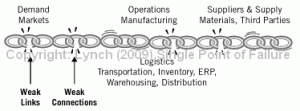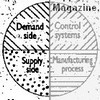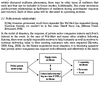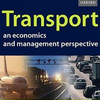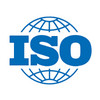 Just out a few days ago, Single Point of Failure
Just out a few days ago, Single Point of Failure is a fascinating read. The author, Gary S. Lynch, is Global Leader, Supply Chain Risk Management Practice at Marsh Consulting, so he knows what he is talking about. The book’s tagline reads “The 10 Essential Laws of Supply Chain Risk Management” and what Gary Lynch is trying to convey is that there are certain basics every manager should know, understand, and act upon. Lynch breaks down Supply Chain Management into ten basic laws, neither founded in academic theories or mathematical formulas, but simple basic principles that anyone can appreciate.
Uncertainty, uncertainty, uncertainty
According to Jean V Murphy of SupplyChainBrain, the title alludes to “choke points” that can jeopardize an organization’s ability to provide value
The root cause is the way that supply chains have been redesigned and reconfigured over the last decade in response to outsourcing, off-shoring and customer/vendor empowerment.
While some good has come from globalization, the downside is that it significantly increases the organization’s exposure to uncertainty, but not all managers are aware of this, let alone the 1o “laws” that govern any business venture.
Globalization: the hidden culprit
Gary Lynch picks up on a notion that I highlighted on this blog last year, namely the 2008 Global Report by the World Economic Forum, where the hyperoptimization of supply chains and the resulting supply chain risk was put forward as a major contributor towards the global risk scenario.
All for one, one for all
In supply chains, everyone is connected. It is impossible to separate the supplier from the company or the company from the customer. The only way the supply chain can work is one for all, all for one.
Click image for larger version
This book shows you how everyone is involved in the supply chain itself, often on several levels at the same time, how the chain is exposed to an infinite number of constantly changing threats; how weak links in the chain represent threats and vulnerabilities, to profitability, continuity, safety and health; and how these threats can be mananged, reduces and eliminated.
The Ten Laws
According to Lynch, these are the ten basic laws of SCM:
- If you don’t manage and lead change you have to surrender to it.
- The paradigm should destroy the parasite. Begin by defining the paradigm, not by fighting the parasite.
- Manage you business DNA in a petri dish of evolving risk.
- In supply chain risk management, demand trumps supply.
- Never set up your supplier for failure
- Managing production risk is a dirty job. Focus on managing the endless risk of manufactured weakest links.
- The logistics risk management rule. Managing the sum of parts does not equal managing the whole.
- Mitigation: If supply chain risk management isn’t the solution, it will soon become the problem.
- Financing: The best policy is knowing what’s in your policy.
- Manage the risk as you manage your own: Your supply chains are all interdependent but unique.
Much of what it comes down to in risk management is just common sense. But in the day-to-day business of managing operations and logistics, the oversight and wider implications of one’s actions are often lost.
Four key points
Again, back to Jean V Murphy, four key points pervade Lynch’s thinking:
- Everyone, without exception, is part of a supply chain.
- No risk strategy is a substitute for bad decisions and a lack of risk consciousness.
- Get the details right but see the whole picture.
- People always operate from their own self interest.
Lynch certainly manages to hammer inn this message, but gently. A longer interview with Gary Lynch can be found on the Kinaxis Blog, where he explains some of his views and ideas.
Conclusion
This book is full of universally applicable real-life examples, obviously written for the practitioner and supply chain professional, and perhaps not so much for the scholar or researcher. Nonetheless, considering the highly affordable price, this is a book that definitely should be in you bookshelf.
Reference
Lynch, G (2009) Single Point of Failure. Hoboken: John Wiley & Sons
Author link
- linkedin.com: Gary Lynch
- blog.kinaxis.com: Getting Supply Chain Risk Management right
amazon.com
- Buy this book from amazon.com: Single Point of Failure
Related
- husdal.com: The new global risk: Hyperoptimization of supply chains
- husdal.com: Are you the weakest link in your supply chain?

